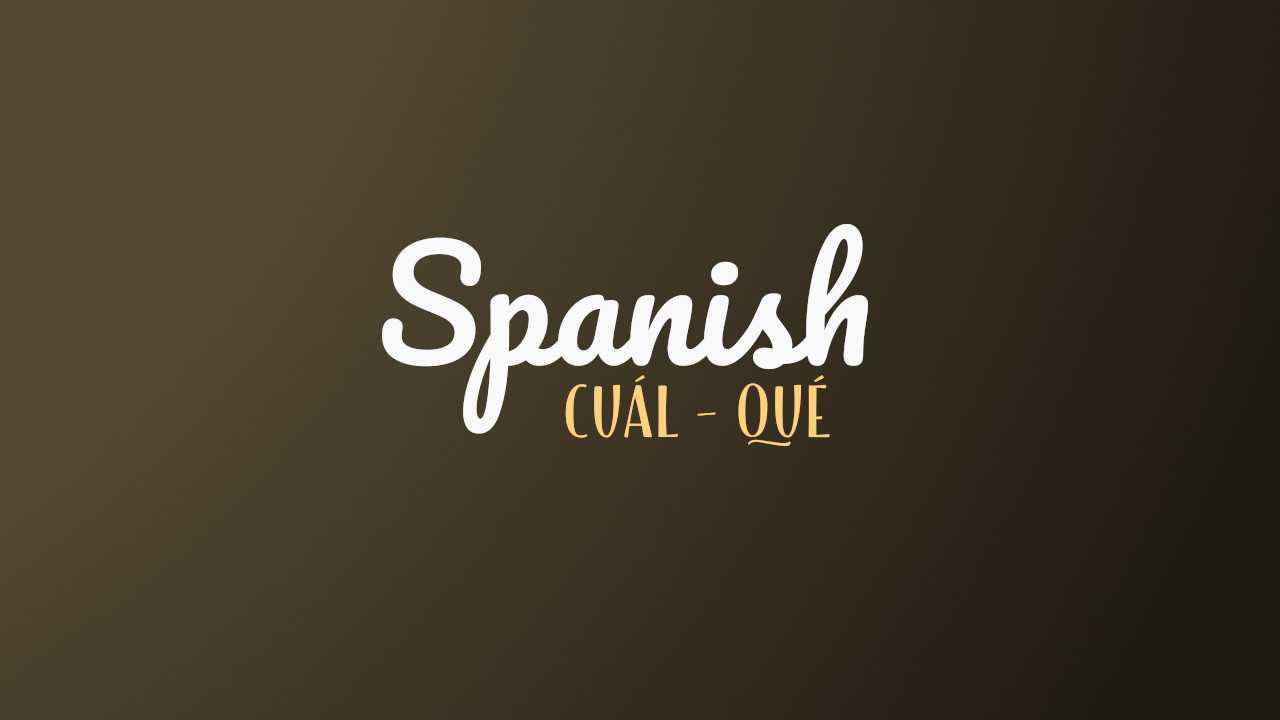You’ve no doubt encountered the words cuál and qué when learning Spanish.
Many Spanish language learners initially struggle to differentiate these two common words, but some rules can help you learn when to use them.
I’ll explain the difference below.
What does qué mean in Spanish?
The word qué is an interrogative adjective and question word when it has an accent mark on the é.
In other contexts, this word can mean “what?”, “which?”, “how”, “that” (when it doesn’t have an accent mark), “than”, “who”, or “so”.
What does cuál mean in Spanish?
Cuál is a pronoun that means “which” or “that” in Spanish.
Since both qué and cuál can mean “what?” and are both question words, it can be difficult to know when to use them.
Which rules can help you choose between cuál and qué in Spanish?
Choosing between cuál and qué is simpler than you might think - a few easy rules can help you select the correct interrogative word.
Let’s consider a few examples of situations when you must choose between cuál and qué, and the rules you can use make the process easier.
1. How to request a definition or information
To request a definition of something, you should use the interrogative opener qué es.
For instance, if you want to know what un otorrinolaringólogo is, you could ask:
¿Qué es un otorrinolaringólogo?
In this case, we use qué + the verb ser to ask for a definition.
However, to ask for information, such as a person’s address, you should use cuál es? For instance, if you ask ¿cuál es tu dirección? (“which is your address?”), the word cuál suggests that the questioner anticipates one potential answer out of a few limited options.
Using qué es (examples)
Consider the examples below to understand how to use qué:

¿Qué es la tristeza?

¿Qué es la esperanza?

¿Qué es un universo?
How to use cuál es (examples)
Check the examples below to see how to use cuál

¿Cuál es tu apellido?

¿Cuál es el mío?

¿Cuáles son las flores más bonitas, las rosas o las orquídeas?
2. How to select one item from more than one option
If you select one item from several options, you will again encounter the dilemma of choosing between cuál and qué.
Let’s consider one scenario that gives us a clear set of rules for when to use cuál and when to use qué.
If you go shopping with your friend to buy several items of clothes, your friend might ask you ¿qué buscas? (“what are you looking for?”).
Once you’ve found two types of trousers, you might ask your friend ¿cuál prefieres? (“which do you prefer?”).
But why do we use qué in one example and cuál in the other?
In the first example, your friend asks you to choose from a heterogeneous group with many options.
Since there are multiple options, the rule, in this case, is to use the word qué.
In the second example, you are asking your friend to select from a few limited potential options, so you should use the word cuál.
Let’s look at a few examples to consolidate what we know about qué vs cuál for selecting one item from many options.
How to use qué for choosing from heterogeneous groups
Check the following examples of how to use qué when choosing from heterogeneous groups:

¿Qué actividades te gustan?

¿Qué música te gusta?

¿Qué debemos hacer este fin de semana?
How to use cuál for choosing from limited potential groups
Consider the examples here to choose from limited potential groups:

Puedes esquiar or surfear.
¿Cuál prefieres?

¿Cuál prefieres? ¿Jazz o reggaetón?
How to use cuál de
If you have heard Spanish speakers using cuál or cuáles de and want to know how this differs from the word cuál, here’s an explanation.
When you use the preposition de with the word cuál, you introduce the object or group you want to choose from and should state the Spanish noun to identify the item.
For example, if you want to ask which car someone prefers, you can use cuál de:

¿Cuál de estos coches de gustó más?
Remember that using qué de requires someone to specify an aspect of the group they like or prefer.
If you ask ¿qué de estos coches de gusto más? you should expect the answerer to respond with one feature of the cars, such as the mirrors or the seats.
3. How to ask for more information about objects
To request more information about objects or ask someone to give more information about something, use qué + the noun in your question.
This sentence structure requires the person to talk about something they cannot see or do not know much about.
Here are a couple of examples:

¿Qué país es el más poblado?

¿Que bebida es la más dulce?
If you need to ask for information about an object the answerer can see or knows about, we should use cuál + the verb.
Check the examples here for more guidance:

¿Cuál tiene más azúcar?

¿Cuál es la más caro?
How to use cuál + the noun (when in Latin America) to ask your question
It’s possible to use cuál + the noun to ask someone for more information about places or objects.
For situations like this, Latin American Spanish speakers use the structure in the following examples:

¿Cuáles gafas son más bonitas?

¿Cuál carro es mejor?
Now you know the difference between qué and cuál in Spanish
The easiest way to get used to the difference between qué and cuál is to use these words when talking to Spanish speakers and pay attention to Spanish natives when they use them.
With the right practice, you will soon fully understand if your sentence requires qué or cuál.
You might also like to check out my guide on ‘which’ in Spanish.
🎓 Cite article
 Grab the link to this article
Grab the link to this article











































COMMENTS
NO ADVERTISING. Links will be automatically flagged for moderation.